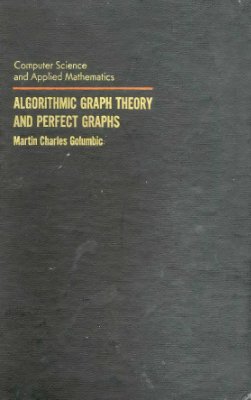Издательство Academic Press, 1980, -303 pp.
Research in graph theory and its applications has increased considerably in recent years. Typically, the elaboration of new theoretical structures has motivated a search for new algorithms compatible with those structures. Rather than the arduous and systematic study of every new concept definable with a graph, the main task for the mathematician is to eliminate the often arbitrary and cumbersome definitions, keeping only the "deep" mathematical problems. Of course, the deep problems may well be elusive; indeed, there have been many definitions (from Dieudonne, among others) of what a deep problem is. In graph theory, it should relate to a variety of other combinatorial structures and must therefore be connected with many difficult practical problems. Among these will be problems that classical algebra is not able to solve completely or that the computer scientist would not attack by himself.
This book, by Martin Golumbic, is intended as an introduction to graph theory through just these practical problems, nearly all of them related to the structure of permutation graphs, interval graphs, circle graphs, threshold graphs, perfect graphs, and others.
The reader will not find motivations drawn from number theory, as is usual for most of the extremal graph problems, or from such refinements of old riddles as the four-color problem and the Hamiltonian tour. Instead, Golumbic has selected practical problems that occur in operations research, scheduling, econometrics, and even genetics or ecology.
The author's point of view has also enjoyed increasing favor in the area of complexity analysis. Each time a new structure appears, the author immediately devotes some effort to a description of efficient algorithms, if any are known to exist, and to a determination of whether a proposed algorithm is able to solve the problem within a reasonable amount of time.
Certainly a wealth of literature on graph theory has developed by now. Yet it is clear that this book brings a new point of view and deserves a special place in the literature.
Graph Theoretic Foundations.
The Design of Efficient Algorithms.
Perfect Graphs.
Triangulated Graphs.
Comparability Graphs.
Split Graphs.
Permutation Graphs.
Interval Graphs.
Superperfect Graphs.
Threshold Graphs.
Not So Perfect Graphs.
Perfect Gaussian Elimination.
Research in graph theory and its applications has increased considerably in recent years. Typically, the elaboration of new theoretical structures has motivated a search for new algorithms compatible with those structures. Rather than the arduous and systematic study of every new concept definable with a graph, the main task for the mathematician is to eliminate the often arbitrary and cumbersome definitions, keeping only the "deep" mathematical problems. Of course, the deep problems may well be elusive; indeed, there have been many definitions (from Dieudonne, among others) of what a deep problem is. In graph theory, it should relate to a variety of other combinatorial structures and must therefore be connected with many difficult practical problems. Among these will be problems that classical algebra is not able to solve completely or that the computer scientist would not attack by himself.
This book, by Martin Golumbic, is intended as an introduction to graph theory through just these practical problems, nearly all of them related to the structure of permutation graphs, interval graphs, circle graphs, threshold graphs, perfect graphs, and others.
The reader will not find motivations drawn from number theory, as is usual for most of the extremal graph problems, or from such refinements of old riddles as the four-color problem and the Hamiltonian tour. Instead, Golumbic has selected practical problems that occur in operations research, scheduling, econometrics, and even genetics or ecology.
The author's point of view has also enjoyed increasing favor in the area of complexity analysis. Each time a new structure appears, the author immediately devotes some effort to a description of efficient algorithms, if any are known to exist, and to a determination of whether a proposed algorithm is able to solve the problem within a reasonable amount of time.
Certainly a wealth of literature on graph theory has developed by now. Yet it is clear that this book brings a new point of view and deserves a special place in the literature.
Graph Theoretic Foundations.
The Design of Efficient Algorithms.
Perfect Graphs.
Triangulated Graphs.
Comparability Graphs.
Split Graphs.
Permutation Graphs.
Interval Graphs.
Superperfect Graphs.
Threshold Graphs.
Not So Perfect Graphs.
Perfect Gaussian Elimination.

